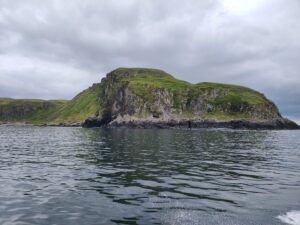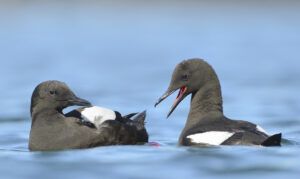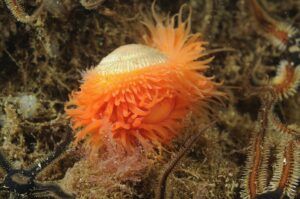Scotland’s seas are renowned for their rich biodiversity. From fish to birds, marine mammals to invertebrates, they are home to thousands of fantastic species of plants and animals. They are loved by communities, are a key component of Scotland’s cultural heritage and identity, as well as a vital resource for those who rely on marine industries like fishing and wildlife tourism.
But scientific evidence makes it clear that Scotland’s marine environment has been in decline for some time. Most of our seabed is in poor condition, with some vital habitats, like seagrass and flame shell beds, covering just a tiny fraction of their former areas. Seabird species are also in steep decline. The overall abundance of 11 seabird species in Scotland went down by a significant average of 49% since 1986, putting Scotland’s seabird health now below the rest of the UK.
We all want our seas to thrive and be resilient in the face of the intertwined climate and nature crises. The livelihood and wellbeing of coastal communities depends on a healthy marine environment. Preserving Scotland’s marine ecosystems, helping them recover, and safeguarding them for future generations is therefore a crucial task. Maintaining and enhancing Scotland’s marine environment is also an obligation under both our international commitments and domestic law.[1]

Image: Fanny Royanez
What are marine protected areas, and why do they matter?
Marine Protected Areas (MPAs) are designated zones within the ocean set aside for long-term conservation objectives. They come in various forms worldwide, each offering different levels of protection and management strategies.
Scientific evidence from across the globe shows that MPAs are a proven tool to halt and reverse the decline of biodiversity, such as Fish Replenishment Areas in Hawai’i, as well as fighting climate change, such as measures detailed in the Great Barrier Reef Blueprint for Climate Resilience and Adaptation. When thoughtfully planned with marine communities, and effectively managed, MPAs become essential in addressing our impact on the marine environment. They can help marine species and habitats to recover, and safeguard established ecosystems from further degradation.
MPAs are a long-term investment. They work to ensure that the species and habitats that make up our complex marine ecosystems are adequately protected, so that future generations can continue to benefit from what our seas provide us with – commercial fish and shellfish, renewable sources of energy, climate regulation, natural coastal defence, and enjoyment, recreation and increased wellbeing across society.
However, designating a site as an MPA does not automatically mean it is protected[2]. Those responsible for MPAs must assess what changes to human activities might be needed within the site to reduce pressure on vulnerable species and habitats and give them the best possible chance to thrive. This might mean some activities have to be restricted or reduced in certain areas, at certain times of the year, or, in the case of higher risk activities, on a permanent basis. The Great Barrier Reef Zoning Plan is considered a successful example of where there is a mixed management approach that supports multiple human uses of the area. The success of a MPA in achieving its conservation goals is highly dependent on the management measures implemented to protect the site.
Scotland’s marine protected areas: management measures are eight years overdue

Image: Ben Andrew
The Marine (Scotland) Act 2010 sets out a duty for Scottish Ministers to protect and enhance the marine environment. Both the Marine and Coastal Access Act (2009) and the Marine (Scotland) Act 2010 provide the Scottish government with the power and duty to create a network of MPAs.
In 2014, 30 nature conservation MPAs were created with the objective of helping protect nationally important species and habitats – Priority Marine Features (PMFs). Designating the sites was only the first step, as management measures to restrict certain marine activities including commercial fishing were to be delivered by 2016.
Fisheries restrictions were adopted in a handful of inshore MPAs (within 12 nautical miles of the coast) in 2016, but the deadline to implement restrictions across the whole network by 2016 was missed. The measures that have been introduced in the most vulnerable inshore sites prohibit damaging fishing methods in less than 1% of the historically fished inshore area[3]. A subsequent deadline of 2020 was also missed. A commitment from the Scottish government in the 2021 Bute House Agreement to complete the MPA network and deliver the long-awaited management measures by 2024 has also not been met, leaving our MPAs without real protection from the most damaging forms of fishing. Repeatedly missing these deadlines put at risk the Scottish Government’s ambition to halt biodiversity loss by 2030.
It’s important to note here that these measures are not related to the proposals for ‘Highly Protected Marine Areas’ (HPMAs) that were mooted by the Scottish government in 2021 and consulted on in 2023. The appropriate management of our MPA network has been on the table for 10 years and has been subject to extensive discussion with stakeholders and local communities. HPMAs, as consulted in 2023, will not be progressed by the Scottish Government (although areas of consensus amongst stakeholders were identified during the consultation which will be helpful for future developments.
The Scottish government’s own data has repeatedly underscored the urgent need to implement management measures for the most damaging forms of fishing. Most recently, its Scottish Marine Assessment 2020 identified fishing activities that sweep across large sections of the seabed (‘bottom-towed mobile’ fishing) and ‘pelagic fishing’ (which refers to the water area between the surface and seabed) as the key pressures facing marine biodiversity, alongside climate change. Yet these forms of fishing are allowed to continue in all but a few of our MPAs.
In short, despite covering 37% of Scotland’s seas, the majority of the MPA network continues to exist in name only without real protection implemented. While fisheries restrictions are delayed, our marine ecosystems, especially seabed habitats, will continue to decline.

Image: NatureScot
Restrictions tailored to species and habitats
NatureScot provided advice to the Scottish government in 2014 on what types of fishing activities would need to be removed or limited in each MPA in order for the relevant species and habitats to be properly protected. The measures would vary for each site and be tailored based on risk to adequately protect the marine wildlife the sites contain. Depending on the MPA, the measures would mean restricting certain types of fishing, but allowing others that have little or no impact on the species and habitats identified.
The Scottish government ran a series of consultations and workshops with marine users and industries to consult on and deliver the management measures. Its proposals were confined to protecting small areas of priority species and habitats that remained in good condition despite decades of industrial activity. Scottish Environment LINK called for a more holistic approach to these management proposals, taking into account how the priority species and habitats are connected as part of the ecosystem, rather than just considering them on their own.
Today, the Scottish MPA network is composed of 233 sites designated for nature conservation purposes. But 10 years after their creation, only a minority of sites have fisheries management measures in place.
This cannot go on. The Scottish government must end the delays and act now to take this crucial step in helping our seas recover.
More is needed to help our seas recover
Delivering an effective network of MPAs is the bare minimum if Scotland wants to halt and reverse the decline of our marine biodiversity. Without these tailored management measures, MPAs cannot reach their conservation objectives.
However, the Scottish government’s approach through MPAs is confined to protecting the small areas of our seas that remain in good condition. If we are to help our seas recover, implementing MPA management measures is only the first step.
MPAs must be part of a broader ecosystem-based approach to tackle the ocean emergency effectively. Urgent action across policy areas is needed to facilitate species and habitat recovery and ensure that marine ecosystems can function. This means implementing a more holistic approach to the management of fisheries, establishing a new national marine plan centred on ocean recovery, and addressing cumulative impacts on the marine environment.
It is urgent we ensure our marine ecosystems can provide the life-sustaining benefits that our marine industries and coastal communities rely on, for generations to come.
Sign the petition calling on the Scottish government to put tailored fisheries restrictions in place across Scotland’s marine protected areas by the end of 2025.
By Fanny Royanez, Marine Policy and Engagement Officer
[1] Scotland is obligated to maintain and enhance its marine environment under international commitments such as the Convention on Biological Diversity (CBD), OSPAR Northeast Atlantic strategy, and delivering on the UN Sustainable Development Goals. It is also a legal requirement under national legislation such as the UK Marine Strategy Regulations, the Marine (Scotland) Act 2010, and the Nature Conservation (Scotland) Act 2004.
[2] Langton, R., Stirling, D.A., Boulcott, P. and Wright, P.J., 2020. Are MPAs effective in removing fishing pressure from benthic species and habitats?. Biological Conservation, 247, p.108511.
[3]Langton, R., Stirling, D.A., Boulcott, P. and Wright, P.J., 2020. Are MPAs effective in removing fishing pressure from benthic species and habitats?. Biological Conservation, 247, p.108511

